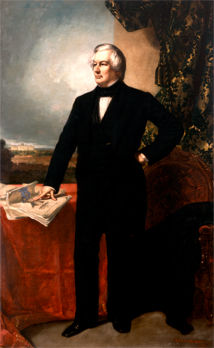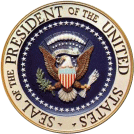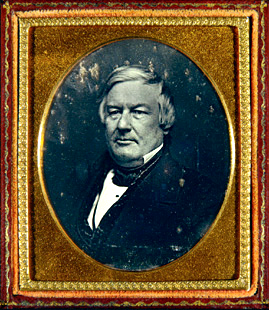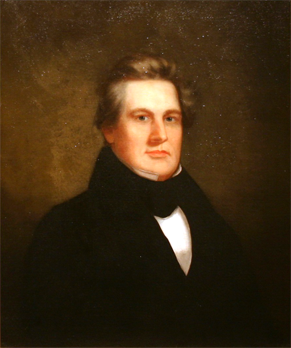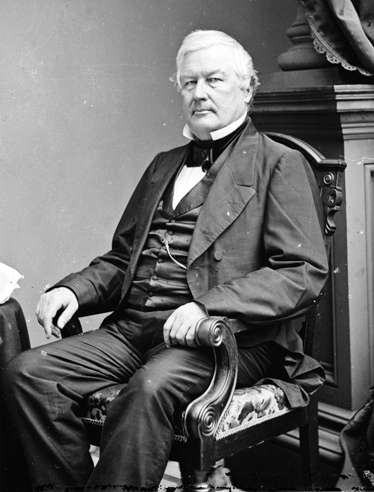|
MILLARD FILLMORE |
|
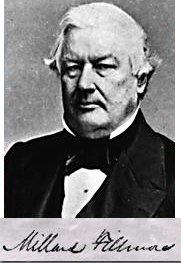
THE 13TH PRESIDENT OF
THE UNITED STATES OF AMERICA
(1850-1853)
FILLMORE, Millard
(1800–74), 13th president of the U.S. (1850–53).Fillmore was born on Jan. 7, 1800, near Locke, N.Y., the son of Phoebe Millard (1780–1831) and Nathaniel Fillmore (1771–1863), recent immigrants from Vermont. Brought up on his father’s farm, he received little schooling. In 1822 he became a law clerk in Buffalo, N.Y., where he was admitted to the bar in 1823. He was married twice, first to Abigail Powers (b. 1798), who died in 1853, and then to Caroline C. McIntosh (1813–81), a wealthy widow from Troy, N.Y.
Early Political Career.
Fillmore entered politics as a member of the Anti-Masonic party. Elected to the state Assembly in 1828, he served until 1831 and soon acquired influence in the party. From 1833 to 1835 and again from 1837 to 1843—having followed his mentor, state Assemblyman Thurlow Weed (1797–1882), into the Whig party—he represented his district in Congress. Subscribing to the Whig economic program of government aid to industry, he was, as chairman of the Ways and Means Committee, largely instrumental in securing the passage of the tariff of 1842. In general, Fillmore was a moderate on the slavery question. In 1844 he ran unsuccessfully for governor but was elected comptroller of New York State three years later, and in 1848 he became Zachary Taylor’s running mate as the successful Whig party’s vice-presidential candidate.
Vice-President and President.
As vice-president, Fillmore encountered difficulties because of President Taylor’s increasing reliance on William H. Seward and Thurlow Weed, who had become Fillmore’s principal opponents within the party in his home state. During the national crisis over slavery in 1850, moreover, he tended to favor Henry Clay’s compromise proposals, while Taylor opposed them. When Taylor died in July of that year and Fillmore succeeded to the presidency, he used his power in support of the compromise, which was passed shortly afterward. Considering this maintenance of sectional peace his greatest accomplishment, he then sought to preserve it at all costs, even though his signature and rigid enforcement of the inequitable Fugitive Slave Law (1850) subjected him to widespread criticism in the North.
In foreign relations, Fillmore promoted America’s developing trade with the Orient; during his administration a U.S. naval expedition under Commodore Matthew C. Perry forced the Japanese to open their ports to Western commerce.
Later Life.
In 1852 the badly split Whigs nominated Gen. Winfield Scott for the presidency instead of the reluctant incumbent, and they were badly beaten at the polls. After his retirement, Fillmore traveled widely and attempted to revive the disintegrating Whig party by collaborating with the growing anti-Roman Catholic and anti-foreign Know-Nothing movements. In the 1856 presidential election he became the standard-bearer of the Know Nothings, now dubbed the American party, but in spite of the endorsement of the remnant of the Whigs, he ran third behind James Buchanan and John C. Frémont.
For the remainder of his long life, Fillmore lived in Buffalo, where he was active in civic affairs. Although he supported the Union during the American Civil War, he was highly critical of the Lincoln administration. He died in Buffalo, on March 8, 1874.
Dignified, modest, and well liked by his associates, Fillmore helped calm the North-South controversy that marked his accession to the presidency. Unable to appreciate the moral dimensions of the antislavery struggle, however, he was not strong enough to provide permanent leadership to the deeply divided nation.
